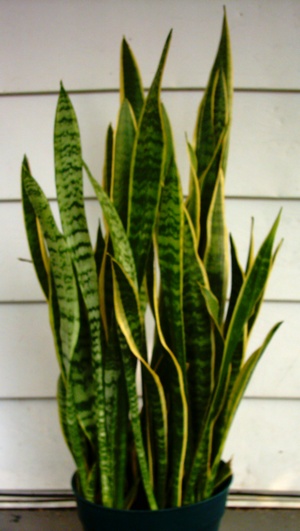Sanseveria trifasciata is a popular houseplant that even plant lovers with the brownest thumb will find hard to kill. This notoriously hardy houseplant will survive much neglect and really doesn’t need a lot of attention to thrive. Also known as the snake plant or sword plant, the Sanseveria is also referred to unflatteringly as “mother-in-law’s tongue” because it has sharp edges and just won’t go away!
The snake plant is a slow-growing plant with stiff, upright leaves that have variegated horizontal bands of dark green and gray-green with a yellow outline, and may reach a height of four feet. The amount of light the individual plant receives will determine its color. Although the snake plant doesn’t need a lot of light to survive, it will be more colorful if it gets plenty of light. A healthy plant will produce greenish flowers on a long spike. The flowers that appear are insignificant and somewhat unattractive, and they may be removed if you wish without harming the plant.
Sanseveria will tolerate dry conditions but do not like to be too wet! Infrequent watering is what they prefer, and in the winter you may water them as little as once a month. Kept too wet, the roots will rot and the plant will die. They can withstand frost down to 28 degrees F for short periods of time, and can be grown outdoors as a perennial in warmer climates.
The snake plant has a thick underground stem that sends out rhizomes. The rhizomes can be left to fill the container or separated from the parent plant and placed in another pot for propagation. The plant can also be propagated from leaf cuttings. Cut one of the leaves into horizontal sections and place them in a rooting medium. Be sure to place the bottom of the leaf section in the medium; if you place it upside down it won’t root. Place the pot inside a large plastic bag with a few holes poked in it to increase the humidity, and the leaf cutting should begin to root in a couple months. The plant may revert to a non-variegated form when propagated by leaf cuttings.
This plant has few pest problems but is susceptible to mealybugs, white cottony scale insects that feed on plant juices. They move slowly and often congregate in crevices. Eliminate them by dipping a cotton swab in rubbing alcohol and dabbing it on the insect. If there are only a few, you may scrape them off with your fingernail.
Sanseveria is an excellent choice to decorate an office or apartment where little natural light is available. Too much direct sunlight may bleach the color, so avoid placing it in a southern exposure. East or west windows are ideal, but the plant will do fine in a north window or hallway, too. Even the unluckiest house plant lover will be able to raise a beautiful snake plant with very little effort!



